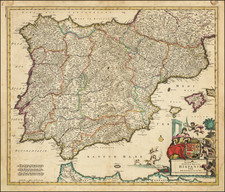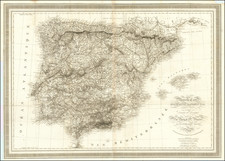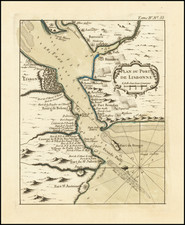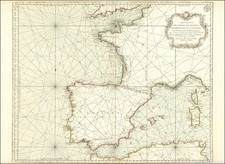Spectacular Theodore de Bry birds-eye view of the island of Terceira and the town of Angra.
De Bry copied the view from that of Linschoten, which is larger and has a different title but is otherwise very similar.
Linschoten's view of Terceira in the Azores is one of the most decorative and recognizable birdseye views engraved in the 16th century. Linschoten served 6 years as the bookkeeper for the Archbishop of Goa (1583-89). While in Goa, as a result of his position, Linschoten had access to secret information, including the nautical maps that were well guarded for over a century. Misusing the trust in him, he began meticulously copying these maps. In 1587, the Archbishop of Goa died while on a trip to Lisbon to report to the King of Portugal, ending Linschoten's stay in Goa. He set sail for Lisbon in January, 1589, passing by the Portuguese supply depot at St. Helena island in May 1589.
Linschoten was "one of the pathfinders for the first Dutch voyages to the East" (Schilder, p. 195). He was in the service of the Portuguese as Secretary to the Portuguese Archbishop of Goa in India from 1583 to 1589. Here, he had access to many Portuguese portolans as well as other valuable commercial information, especially as Goa at this time was the commercial and political center for the Portugal Empire in the East. Van Linschoten left Goa for home in January 1589. On the way to Portugal, his ship was pursued by an English fleet and lost its cargo in a storm while anchored off the Azores. After the loss of the cargo, Van Linschoten was persuaded to stay and help recover it; he spent two years on Tercera, working and preparing his notes from Goa. Van Linschoten eventually arrived in Lisbon early in 1592, and then sailed home to The Netherlands. His account of his experiences is one of the most important travel works of the period.
Angra do Heroísmo is the principal city of the Island of Terceira, the major port and trading town in the islands. Terceira became the principal port of In 1583, Philip II of Spain, as king of Portugal, sent his fleet to clear the Azores of a combined multinational force of adventurers, mercenaries, volunteers and soldiers who were attempting to establish the Azores as a staging post for a rival pretender to the Portuguese throne. Following the success of his fleet at the Battle of Ponta Delgada, the captured enemy were hanged from yardarms, as they were considered pirates by Philip II. (This was added to the "Black Legend" by his enemies.) An English expedition against the Azores in 1597, the Islands Voyage, also failed. Spain held the Azores in what is called The Babylonian captivity of 1580-1642.
Theodor de Bry (1528-1598) was a prominent Flemish engraver and publisher best known for his engravings of the New World. Born in Liege, de Bry hailed from the portion of Flanders then controlled by Spain. The de Brys were a family of jewelers and engravers, and young Theodor was trained in those artisanal trades.
As a Lutheran, however, his life and livelihood were threatened when the Spanish Inquisition cracked down on non-Catholics. De Bry was banished and his goods seized in 1570. He fled to Strasbourg, where he studied under the Huguenot engraver Etienne Delaune. He also traveled to Antwerp, London, and Frankfurt, where he settled with his family.
In 1590, de Bry began to publish his Les Grands Voyages, which would eventually stretch to thirty volumes released by de Bry and his two sons. The volumes contained not only important engraved images of the New World, the first many had seen of the geographic novelties, but also several important maps. He also published a collection focused on India Orientalis. Les Grands Voyages was published in German, Latin, French, and English, extending de Bry’s fame and his view of the New World.










![[ Tracking The Armies of Bonaparte and the English During The Peninsular Campaign ] New Map of Spain and Portugal By E. Mentelle, Member of Institute of Science at Paris, and P. G. Chanlaire, One of the Authors of the National Atlas](https://storage.googleapis.com/raremaps/img/small/99148.jpg)



